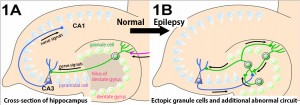Understanding epilepsy Impact of infantile seizures on neural development

Todai researchers have described the mechanism by which infantile febrile seizures may lead to adult epilepsy, with important implications for current treatment.
The violent full-body seizures that accompany epilepsy affect some 1% of the world’s adult population. Temporal lobe epilepsy (TLE), which accounts for a significant fraction of these cases, is an intractable neurological disease that does not respond to treatment with drugs. While it was known that as infants many TLE patients experienced complex febrile seizures that continued for many minutes, the cause of TLE and its association with infantile seizures remained unknown.

Left: normal rat hippocampus. Granule cells form a thick granule cell layer (GCL, green). Nerve signals are input to the granule cells via dendrites on the exterior side of the dentate gyrus, from where they are passed via long axons to region CA3 of the hippocampus. Pyramidal cells in CA3 transmit the signal on to region CA1 of the hippocampus (black arrows). Right: hyperthermic rat hippocampus. Ectopic granule cells extend axons to both region CA3 and to the outer layer of the dentate gyrus, and pyramidal cells form an additional abnormal circuit by connecting back to the granule cells. Region CA3 is often implicated in epilepsy. © Yuji Ikegaya
Researchers already had some clues as to where to start. The human hippocampus is not completely formed until about three years old, at which time neurons are correctly placed and connected. However, it was known that some of the granule cells that form a thick layer in the hippocampus were misplaced in the brains of TLE patients. In other words, it was clear that adult epilepsy is in some way connected to infant neural development.
Assistant Professor Ryuta Koyama and a research team lead by Associate Professor Yuji Ikegaya in the Laboratory of Chemical Pharmacology at the University of Tokyo Graduate School of Pharmaceutical Sciences used a rat model to demonstrate that adult epilepsy is caused by developmental defects in the hippocampus as a result of infantile febrile seizures.
Misplaced (ectopic) granule cells were also found in the hippocampuses of rats that experienced febrile seizures during infancy. When febrile seizures occur, granule cells become easily excitable by the neurotransmitter GABA, and as a result some do not migrate to the correct location. The research group demonstrated that administering the drug bumetanide to inhibit the action of the transporter protein NKCC1, which supports the action of GABA, also blocked the formation of ectopic granule cells and prevented the emergence of adult epilepsy.
The current treatment for infantile complex febrile seizures is to administer a GABA agonist. However, this research using a rat model indicates that this treatment may be increasing the risk of adult epilepsy. Ongoing research will clarify the applicability of this result to human epilepsy.
(Public Relations Division, The University of Tokyo, Azusa Minamizaki, Euan McKay.)
Department release/press release (Japanese)
Paper
Ryuta Koyama, Kentaro Tao, Takuya Sasaki, Junya Ichikawa, Daisuke Miyamoto, Rieko Muramatsu, Norio Matsuki & Yuji Ikegaya
“GABAergic excitation after febrile seizures induces ectopic granule cells and adult epilepsy”
Nature Medicine 18, 1271–1278 (2012). doi:10.1038/nm.2850
Article link
Supplementary information link
Links
Graduate School of Pharmaceutical Sciences







